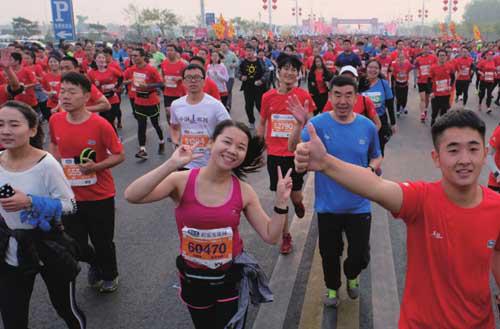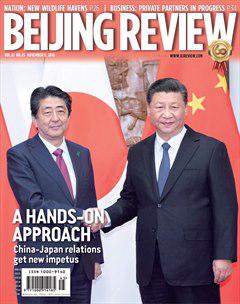Old Is Gold
By Zhao Piao

During autumn nights, its common to see strollers walking appreciatively on the town wall in Zhengding, an ancient county in north Chinas Hebei Province. The wall is one of the few remaining segments of the ancient fortification built during the Ming Dynasty (1368-1644) and preserved to the present day. Standing on it, visitors can see four old pagodas lined up from south to north, forming a spectacular sight. The wall and other ancient monuments have brought new opportunities for the local tourism industry amid the Central Governments initiative to develop all-region tourism, in which an entire region is developed as a tourist destination.
Zhengding has a rich history as it survived nine dynasties without any interruption, enabling it to possess a great variety of cultural artifacts. History and culture are at the heart of Zhengdings tourism industry. The county has always sought to restore its ancient town and preserve cultural artifacts, using its legacy to develop tourism.
The local government has been preserving and restoring old monuments in recent years and repairing the ancient town wall was a key project. The government restored the southern gate of the town and 5.2 km of the wall, also building relic parks and installing lights on a stretch of the wall. The project cost 230 million yuan ($33 million).
Blockbuster destination
In 2017, Zhengding adopted a p lan for its development as well as the restoration of its old town. The plan details 25 projects, of which 20 have been completed and opened to the public. They include renovation of the surrounding areas of Rongguofu, a cluster modeled on the architecture of the Ming and Qing (1644-1911) dynasties. The local government built the complex in the 1980s to provide a shooting location for the hit TV drama series based on Dream of Red Mansions, the 18th-century classic written by Cao Xueqin. When the complex opened to the public, it became a prime tourist destination. The other projects being implemented include the countys fi rst museum, to be fi nished by the end of the year.
Liang Sicheng (1901-72), a renowned architect and scholar known as the father of modern Chinese architecture, visited Zhengding three times. The county authorities consulted the notes he made on how the county should preserve its architecture, Cui Weili, Deputy Director of the Zhengding Cultural Heritage Preservation Institute, said.


This March, the General Offi ce of the State Council, Chinas cabinet, issued a guideline on developing all-region tourism, which stressed upgrading the tourism industry, improving its quality and effi ciency, and improving the environment for tourism development.
Zhengding has taken several measures to develop its tourism industry.
It has sought to address the problem of traffic congestion and lack of parking space. Government departments and public institutions located on main streets were asked to demolish their perimeter walls to provide free parking lots for the public.
The local Party committee and government compound was the fi rst to demolish its walls to set an example. Wang Hong, a security guard, said every day local residents and tourists park their cars in the yard. “Sometimes when there is no parking space in the yard, staff members will park their own cars in a parking lot on the opposite side of the road,” Wang said.
The local authorities plan to build more free parking lots, eyeing a target of 25,200. They are also addressing tourists diffi culty in fi nding restrooms. Visitors can now use the toilets in government offices and public institutions. In addition, Zhengding has built and renovated over 600 toilets.
Long-term plan
The long-term plan is to shift the focus of the tourism industry from sightseeing tours to those spent savoring the city and experiencing the culture. Zhengding aims to be a tourist destination combining the historical ambience of an ancient town, the glamor of a modern industrial hub and the beauty of its countryside sceneries.
Benches and water dispensers have been installed in scenic spots and service counters established along roads. There are also cars for shared rides and vehicles for free sightseeing rides.
Tourism has come a long way, becoming a pillar industry of the county. As of October 27, the number of tourist arrivals reached 12.3 million, increasing 160 percent year on year, while tourism revenue topped 5.6 billion yuan ($804 million), a whopping 179-percent increase.

